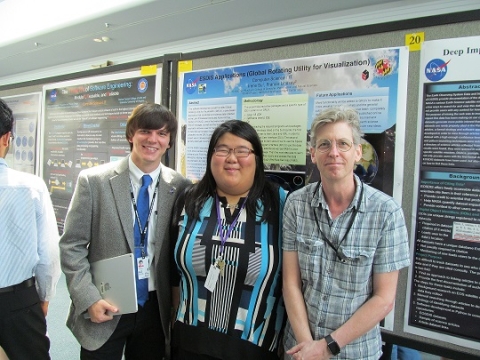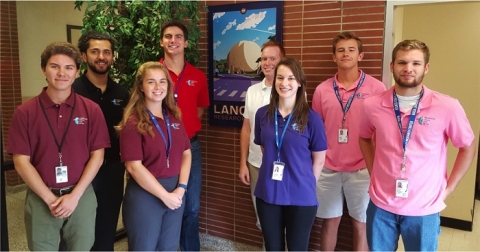The road to a NASA career may run through Metropolitan State University in Minneapolis, MN. Or perhaps Stevens Institute of Technology in Hoboken, NJ. Or even Poquoson High School in Poquoson, VA. Students from these schools, and from high schools, colleges, and universities across the country, supported NASA's Earth Observing System Data and Information System (EOSDIS) projects this summer as interns at EOSDIS Distributed Active Archive Centers (DAACs) and NASA centers and facilities.
NASA’s Goddard Space Flight Center in Greenbelt, Maryland, hosted 425 interns this summer, including three working on projects in the Earth Science Data and Information System (ESDIS) Project office and two working on projects at NASA's Goddard Earth Sciences Data and Information Services Center (GES DISC). Before heading back for their fall semesters, the Goddard interns gathered in the atrium of Building 28 for an Intern Showcase to show off a summer of hard work.
Jacob Moore, a rising sophomore at Northern Kentucky University majoring in computer science, is one of three interns supporting ESDIS. Jacob spent the past 10 weeks working on a mobile application developed by NASA’s Land Processes DAAC (LP DAAC) to enhance user interfaces with their data. “I worked on the iOS-based LandCast application,” he says. “It was almost finished, but I had to go in and fix a few bugs. I also developed a user guide for the application that details everything the application does.”
Around the corner from Jacob, Irene Su, a rising sophomore computer science major at the University of Maryland and another ESDIS intern, describes her project to a small group of NASA scientists and engineers. Like Jacob, Irene also is working on an application developed by LP DAAC, the Global Rotating Utility for Visualization (GRUV). GRUV is a graphical user interface (GUI) that allows users to explore various Earth data layers collected from LP DAAC. “I originally was going to work on the Android version of LandCast, but after the first few weeks I branched off to work on GRUV,” she says. “I’ve mostly been fixing various bugs, adding new functions to make GRUV more user-friendly, and also making the GUI compatible for both Windows and Mac operating systems.”
Next to Irene, Sameena Bajwa, a rising junior computer science major at Boston University and the third summer intern supporting ESDIS, describes her work developing software to help solve an ongoing problem—determining specific ESDIS datasets referenced in scientific articles in the absence of proper dataset citations. “Right now, the only way for ESDIS to track who is writing about our data is to use citations, but we can’t rely on authors to properly cite our data,” she says. “Once I found enough of a trend [in the data], I wrote programming in Python to find links to the datasets.”
The work of Jacob, Irene, Sameena, and other NASA interns is critical to moving projects forward or laying the groundwork for new missions. “[Sameena’s] data citation project is one we’ve been wanting to start on and work on, but everyone is so busy that we just haven’t been able to get to this,” says Evelyn Ho, an ESDIS systems and software engineer and ESDIS liaison with Goddard’s Office of Education. “We’ll be able to work off of what she’s done and move this project forward.”
In fact, the efforts and insight of summer interns are a key element in moving hundreds of NASA projects forward. Each fall, NASA puts out a call for projects to be added to the NASA Interns, Fellows & Scholars One Stop Shopping Initiative (NIFS/OSSI) website. Through the NIFS/OSSI website, students can search and apply for all NASA internship, fellowship, and scholarship opportunities in one location. A single application places a student in the applicant pool for consideration by all NASA centers.
NASA internships are available for high school, undergraduate, and graduate students. High school interns must be at least 16 years old and a current sophomore, junior, or senior; undergraduate and graduate students must be accepted or enrolled full-time in an accredited U.S. college or university. Along with a GPA of 3.0 on a 4.0 scale, perspective interns must be U.S. citizens. (NASA internships for international students from select countries are available through the NASA International Internship Program.)
Competition for the limited number of NASA internships is strong. “For each ESDIS opportunity [at Goddard] this year, we had about 20 applicants,” says Ho. “It was a difficult decision to narrow these applicants down to the top candidates since all our applicants were very qualified and had good relevant experience.”
Every intern works under the supervision of a mentor, and sometimes more than one mentor. Mentors play an important role in not just helping interns with their assigned projects, but also passing along the experience and knowledge they have acquired through their years at NASA. Dr. Frank Lindsay, an ESDIS systems engineer, is the mentor for Jacob and Irene, and notes that part of his role is to help students understand how their work fits into the larger NASA and ESDIS missions.
“It’s important for them to know what ESDIS does and why it’s important for NASA to be collecting these data,” says Lindsay. “We are a science agency, so everything we do relates back to the science. It’s critical for them to understand the reasons behind why they’re working on the project they’ve been given and the reasons behind why the app was developed and the scientific questions the app helps answer. I want them to take away this knowledge.”
Along with the ESDIS and GES DISC interns at Goddard, more than 25 interns supported projects at many of the EOSDIS discipline-specific DAACs around the country.
“When we bring in an intern, we’re bringing them in to serve a specific purpose. This is work that needs to be done and projects that help us accomplish our mission,” says Walt Baskin, lead scientific programmer/analyst at ASDC and a mentor to four ASDC interns. “The beautiful freedom of this internship program is that our focus is not just limited to the specific task; it’s to expose them to as much as they’re able to take in.”
ASDC also has the highest number of high school student interns of any DAAC: six. “I don’t treat my high school students any differently than I would treat a graduate student,” Baskin says. “What I’ve noticed this year is that our high school students are able to do more technical computer programming. Some of my high school students have accomplished tasks I would normally expect from a graduate student.”
Back at the Intern Showcase in Goddard’s Building 28, Elaine Keim, who recently received her bachelor’s degree in geosciences with a minor in atmospheric science from Texas Tech University, describes her work supporting a GES DISC project. Elaine developed a climatology for the Giovanni data visualization and analysis system using data from the Atmospheric Infrared Sounder (AIRS) instrument aboard NASA’s Aqua Earth observing satellite. “I looked at the difference between two averaging methods for these data: a weighted and an unweighted average,” she says, pointing to her analysis on the large poster behind her. “I found that there is a significant difference between the data produced using these two methods.”
While continuing her GES DISC work this fall, Elaine also will be taking graduate-level classes at the University of Maryland toward a master’s degree in atmospheric science.
Nearby, Kush Bhakta, a rising junior mechanical engineering major at the Missouri University of Science and Technology, describes how he was able to combine his academic studies with his interest in unmanned aerial systems (UAS) to support a GES DISC data management project. As Kush notes, one problem with UAS or drone data is that while a lot of data are being produced, there are as yet no formal standards for organizing and preserving these data.
Kush created two databases. The first is a catalog of drone aerial data, which currently holds aerial photography. The other is a database of how people are using drones in the Earth sciences, including information about pre- and post-flight software used in the drone community. Along with GES DISC staff, Kush also worked with members of the Earth Science Information Partners (ESIP) Drone Cluster on his project. “The purpose [of this project] is to answer several questions: who is collecting data, how are they collecting these data, where are these data being collected, and what data are they collecting,” he says. “Answering these questions will give us a real good view of the landscape of drones and from this we’ll get a better idea about how these data are being collected and how the data are being used in the Earth sciences.”
Of course, the intern experience involves more than simply working on tasks. Interns participate in many enrichment, networking, and social activities. Walt Baskin notes that the ASDC interns have tours and other activities every afternoon, including social gatherings where interns, mentors, and ASDC staff talk about issues as colleagues and developers. Intern activities at Goddard include a lecture by Nobel laureate and NASA astrophysicist Dr. John Mather, tours through laboratories and facilities, and participation in programming boot camps. “Interns certainly aren’t stuck in a cubicle working on a project for 10 weeks,” says Evelyn Ho. “We encourage them to network and build connections and really see how things go on here at NASA.”
If the reaction of the interns to their summer at NASA is any indication, the program is accomplishing its goals.
“This is where I want to work someday,” says Jacob Moore. “It’s great to learn how NASA employees interact with their colleagues and how work is done in this environment. To just experience this puts me light years ahead of where I was before this internship.” Like Elaine Keim, Jacob is continuing his NASA internship in the fall, this time at NASA’s Kennedy Space Center in Cape Canaveral, FL, where he will work on flight software for the Orion spacecraft.
Irene Su and Sameena Bajwa agree with Jacob. “You know that if you're working on a NASA project, then you’re making a large impact at NASA,” says Irene. “I feel that if you work here you just get really inspired, especially when you hear about other people’s stories and their experiences working here.”
“Everything was brand new to me and I’ve learned a lot,” says Sameena. “I really like how you’re doing something worthwhile that’s going to be important.”
For this summer’s ESDIS and DAAC interns, all roads led to a valuable experience that they will take with them not only back to their campuses across the country, but, possibly, back to NASA as the next generation of NASA employees.
Additional Information
For more information about the NASA internship program and to search available internship opportunities, visit the NASA NIFS/OSSI website: https://intern.nasa.gov/ossi/web/public/main.

